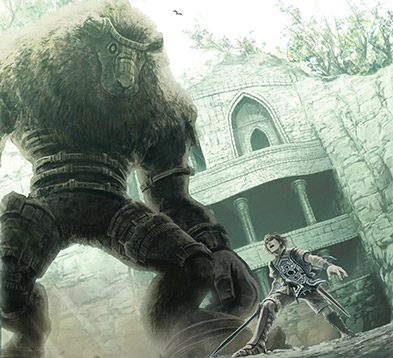G33K LYFE: A decade of the colossus
 CREDIT: SONY COMPUTER ENTERTAINMENT
CREDIT: SONY COMPUTER ENTERTAINMENTShadow of the Colossus is a PlayStation 2 game that illustrates how videogames can exemplify true art.
What is art? Ask a passer-by this question and you will likely hear the same recycled answers. Art is a painting, music, a poem, or film; even the dictionary definition suggests what the ‘typical’ art mediums should be. Others will tell you that art is wholly subjective, that it can be found in anything, as long as it provokes an emotional response.
Regardless of an individual opinion, art is widely regarded to exist within all common forms of entertainment, yet for video games the concept is often dismissed out of hand despite advocates arguing for the contrary.
In 2005, the argument would be forever changed with the release of Shadow of the Colossus, a PlayStation 2 title from the mind of Fumito Ueda, whose directorial experience at that point consisted of a single game.
All of a sudden, gamers had something to show off to the world, something to toss into the face of industry critics and dare them to critique it using their preconceived notions of gaming. In the decade since its release, the title’s legacy has grown, and it is now regarded as one of the most important titles in the history of gaming.
Shadow puts players in the role of a young man named Wander on a quest to save the woman he loves. In order to do so he must slay 16 monsters, the Colossi, at the behest of a mysterious entity who possesses the power to raise the dead. As the journey progresses, it is discovered that the entity is an ancient evil that had been sealed away and has been manipulating Wander to be set free.
While the plot sounds like nothing special, even boring, the beauty of Shadow of the Colossus is found in the execution of that journey. Very few games give players an opportunity to think about what just happened because they’re too busy thinking about what is currently happening. The moments of quiet contemplation provided in Shadow are something rare, and a perfect example of the game’s adherence to minimalism. It can be found everywhere, from the lack of dialogue, to the blasted desolation of the landscape.
The world is empty, a flat expanse broken only by the odd mountain or lake and dotted with ancient ruins. There are no enemies, no NPCs, nothing. Just Wander and his trusty horse Agro off to kill 16 monsters. While riding to a fight the game is silent except for the sound of Agro’s hooves.
The Colossi themselves are a triumph of creature designs. Ranging from the size of an elephant to the size of a skyscraper, these beasts are all unique looking and unique acting. They express themselves through movement and animalistic roars, yet somehow you can tell what they are thinking, and that is where the true beauty of Shadow comes into play.
The prospect of climbing a building-sized monster and taking it down with a tiny sword sounds like the most epic thing you could do in a game, but when you’re doing it something just seems wrong. Slaying a savage beast to save your love seems like an admirable task for any video game protagonist, but the biggest issue with the Colossi is that they are completely passive. Most don’t attack unless provoked and some don’t attack at all, merely aim to defend themselves, trying to shake Wander off before he can hurt them again.
It’s something special when a game can make you empathize with your target in such a way and even more special when it actively makes you question your actions as you take them.
Wounding a Colossus, hearing its pained cry and watching it desperately attempt to throw you off is disturbing, creating a sense of cognitive dissonance. When felled, the rousing orchestral music stops, replaced by a far more sombre theme that is at odds with the moment of triumph the player should be feeling at the time. Killing a giant should make players excited, but the game treats each victory as the tragedy that it truly is.
Shadow of the Colossus is art by all definitions of the word, created by humans and provoking emotional responses. The open-ended characteristics of the story allow players to take from it what they will. The combination of music, design and premise created something that the industry had never seen before, and something that hasn’t been seen since. It is indisputably one of the most important titles ever released and as it approaches its 10th anniversary, finds its legacy forever safe.














